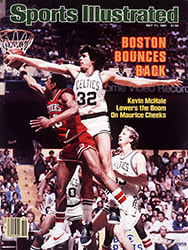
He's a different drummer
Drum roll, please. Tom (Willie Mays) Akins, principal tympanist for the Indianapolis Symphony Orchestra and manager-first baseman of the orchestra's softball team, is pacing nervously in the coaching box at third. His ISO Metrics are trailing the Butler University Band 16-15 in the bottom of the seventh, last ups, and there are two on and two out as Rightfielder-Double Bassman Bud Boerner steps in.
The last time the struggling Boerner took his turn. Akins had shouted, "Bud, you're due, but don't think about it." Boerner had thought about it and grounded into an inning-ending double play. But this time Akins is quiet—until Boerner's shot into left has Akins waving home both runners for the ISO Metrics' first win of the season.
Akins, 37, knows silence is best if that's what the score calls for. It's a talent developed not just behind a set of kettle drums but over seven seasons spent enlivening radio broadcasts of the Indianapolis Indians' home games. Except for evenings when symphony concerts demand his presence, Akins is at Bush Stadium taking pregame notes, doing seven innings of color commentary, relieving sidekick Howard Kellman for two innings of play-by-play, interviewing a star of the game and reading scores of other games from the dugout steps—usually by flashlight after the park is dark.
"I'm in a 'Got my cake and can eat it, too' situation," he says. "I'm playing major league music and announcing Triple A baseball, according to my schedule. The only thing that would be better would be to move to the majors in broadcasting. I think I could do it, but there aren't many jobs and there are a lot of good broadcasters."
When Akins joined the ISO in 1965 he discovered that Max Schumacher, the son of the orchestra's contrabassoonist, was president and general manager of the Indians. Eventually he teamed with the younger Schumacher to arrange pregame promotions featuring the ISO in concert and the ISO Metrics in action. But Akins' moonlighting sonata didn't begin until 1975, when the Indians, a Reds affiliate, lost half of their two-station network and couldn't afford to keep Kellman. "I told the ball club, 'Let me make a' demonstration tape and if you like it, let me be your home broadcaster,' " Akins says. "The station would provide its own broadcaster for games where there was a symphony conflict. They liked the tape, and so did the station." The next year the American Association team added another station, rehired Kellman and kept Akins as color man.
"I'm so fortunate to be able to work with him," says Kellman. "It's his avocation, but he has such a professional attitude. There are pros who don't take it as seriously as he does." During a two-week tour of Florida with the orchestra in March, for instance, Akins visited 11 spring training camps, conducting interviews and gathering background information, while donning tails for seven performances.
In the same dreamy way young boys want to become firemen or railroad engineers, Akins grew up in Roanoke, Va. wanting to become a baseball broadcaster. But he picked up the drumsticks at 13 and wound up in a profession in which the odds against making it are just as long. There's another similarity between percussionists and broadcasters. "Percussionists tend to be soloistic by nature," says Akins, who attended the University of Cincinnati's music school on a scholarship. "It's very hard to hide a sound or recall it if you make a mistake. It allows you to build your confidence because you do your thing in front of people."
An uncle who had once been a semipro pitcher introduced him to baseball during the early 1950s, and The Mutual Game of the Day with Al Heifer and trips to the local grocery for gum cards sustained his interest. Akins remains an avid collector. Among his 200,000 cards, stowed in fireproof files next to the marimba, conga and tympani in his studio, are arcana known to serious hobbyists as B-18 blankets. They're flannel squares adorned with players' likenesses that your mother, rather than throwing them out, would probably find useful as cocktail coasters. "The pride of the house," Akins calls them, though his wife, Alice, and their boys, Danny, 13, and Kenny, 11, make strong claims to that title.
Akins also has two cats and time for church most Sunday mornings. His low-key announcing style suggests as much. "[Reds broadcaster] Marty Brennaman's is a style I like," says Akins, referring like so many baseball people in Indianapolis, half wistfully, half admiringly to anything associated with the parent club. "It's relaxed and conversational. He sounds like the kind of person people want to meet; even without knowing him, they're sure they'll like him."
Despite all the concerts, rehearsals and ball games, Akins finds time to teach percussion in his home and at DePauw University, help coach Kenny's Little League team, direct and play in a percussion ensemble called Sonic Boom, stage Indy's annual card show, perform on commercial jingles, produce and market an annual set of Indians baseball cards and host Symphony Backstage, a biweekly TV show focusing on the activities of the ISO. Five years ago he even staged a "Sports Night at the Symphony," featuring ex-Bengal Lineman Mike Reid on piano, Mariner Manager Maury Wills on banjo and the ISO under the baton of former Pacer Guard Billy Keller.
Akins may yet find his way to the bigs this season, if he can firm up a date to play in Riverfront Stadium—play softball, that is, with the ISO Metrics. The opponent: the archrival Cincinnati Symphony Fantastiques.
PHOTO
Akins beats out Mahler's 6th for the big league Indianapolis Symphony.
PHOTO
Akins also covers Indy's minor league team.

